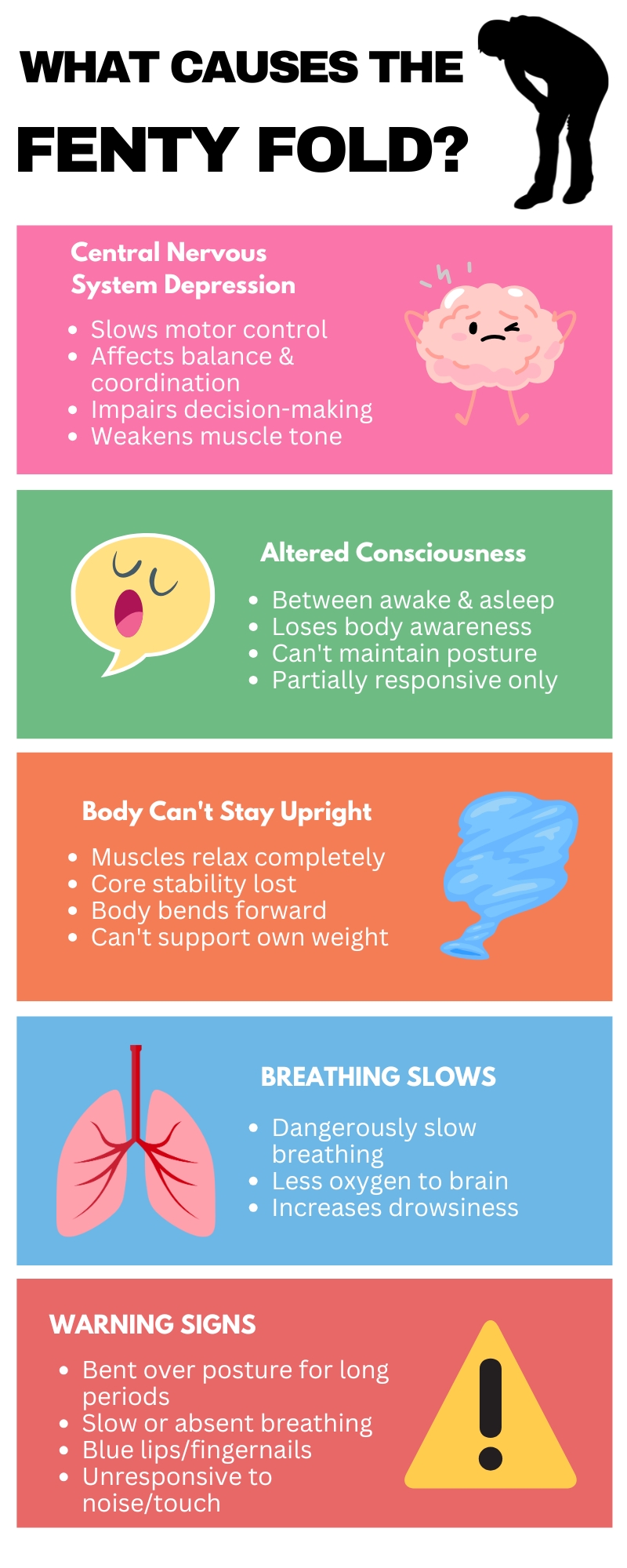If you’ve walked through certain urban areas or witnessed someone under the influence of opioids, you may have noticed a distinctive posture: individuals bent over at the waist, appearing to be frozen in an unnatural position. This phenomenon, known as the “fentanyl fold” or “fentanyl lean,” has become increasingly common as fentanyl addiction continues to devastate communities across the United States.
Understanding the fentanyl fold is crucial for recognizing the signs of fentanyl use, understanding its dangers, and knowing when to seek emergency help. At Healthy Life Recovery, we’ve seen firsthand how this deadly synthetic opioid affects individuals and families, and we’re committed to providing education and comprehensive addiction treatment to help people overcome fentanyl dependency.
What Is the Fentanyl Fold?
The fentanyl fold describes the characteristic posture adopted by individuals under the influence of fentanyl or other powerful opioids. Users appear to be “frozen” in a bent-over position, often with their upper body folded forward at an extreme angle, sometimes nearly touching their knees. This stance can last for extended periods, sometimes hours, while the person remains semi-conscious but largely unresponsive to their surroundings.
Other terms used to describe this phenomenon include:
- Fentanyl lean
- Fenty fold
- The nod
- Dope lean
- Opioid stupor
While this posture can occur with other opioids, it’s become particularly associated with fentanyl due to the drug’s potency and widespread availability in the illicit drug supply.
Why Does the Fentanyl Fold Happen?
The fentanyl fold occurs due to the drug’s powerful effects on the central nervous system. Fentanyl is a synthetic opioid that is 50 to 100 times more potent than morphine and significantly stronger than heroin. When someone uses fentanyl, several physiological processes contribute to this distinctive posture:
1. Central Nervous System Depression
Fentanyl dramatically slows down the central nervous system, affecting:
- Motor control and coordination
- Balance and spatial awareness
- Conscious decision-making
- Muscle tone and posture maintenance
2. Altered Consciousness States
Users experience what’s often called “nodding off” – a state between consciousness and unconsciousness where they:
- Lose awareness of their physical position
- Cannot maintain normal posture
- Remain partially responsive but severely impaired
3. Muscle Relaxation and Weakness
Fentanyl causes significant muscle relaxation, leading to:
- Inability to maintain upright posture
- Loss of core stability
- Gradual forward bending as muscles can’t support body weight
4. Respiratory Depression
One of fentanyl’s most dangerous effects is slowing breathing to dangerously low levels, which can cause:
- Reduced oxygen to the brain
- Increased drowsiness and stupor
- Further impairment of motor control

The Dangers of the Fentanyl Fold
While the fentanyl fold might appear as simply an unusual posture, it represents a medical emergency in progress. The bent-over position indicates severe intoxication and carries multiple serious risks:
Immediate Physical Dangers
Respiratory Compromise: The folded position can further restrict breathing, which is already dangerously slowed by fentanyl’s effects. This compression of the chest and abdomen can lead to:
- Reduced lung capacity
- Inadequate oxygen intake
- Risk of respiratory failure
Circulatory Issues: Remaining in a bent position for extended periods can cause:
- Blood pooling in the lower extremities
- Reduced circulation to vital organs
- Potential for blood clots
Injury Risks: Users in the fentanyl fold are vulnerable to:
- Falls that can cause head injuries or broken bones
- Burns from cigarettes or other heat sources
- Injuries from traffic or other environmental hazards
- Pressure sores from prolonged positioning
Risk of Overdose
The fentanyl fold often indicates that someone is on the verge of, or already experiencing, an overdose. Warning signs that require immediate emergency intervention include:
- Extremely slow or absent breathing (fewer than 10 breaths per minute)
- Blue lips, fingernails, or skin (cyanosis)
- Cold, clammy skin
- Weak pulse
- Unresponsiveness to loud noises or physical stimulation
- Gurgling or choking sounds
If you witness these signs, call 911 immediately and administer naloxone (Narcan) if available.
Understanding Fentanyl’s Impact on Communities
The Scope of the Crisis
The prevalence of the fentanyl fold in public spaces reflects the broader fentanyl crisis affecting communities nationwide:
- Fentanyl is involved in more than 70% of overdose deaths in the United States
- The drug has contaminated much of the illicit drug supply, affecting users of cocaine, methamphetamine, and counterfeit prescription pills
- Many people develop fentanyl addiction unknowingly through contaminated substances
Why Fentanyl Is So Dangerous
Several factors make fentanyl particularly deadly:
Extreme Potency: A dose as small as 2 milligrams can be lethal – equivalent to a few grains of salt
Rapid Onset: Effects occur quickly, often before users realize they’ve taken too much
Short Duration: The “high” is brief, leading to frequent redosing and increased overdose risk
Unpredictable Potency: Street fentanyl varies widely in strength, making safe use impossible
Recognizing Someone Needs Help
While the fentanyl fold is a clear indicator of intoxication, other signs that someone may be struggling with fentanyl addiction include:
Physical Signs:
- Constricted (pinpoint) pupils
- Drowsiness and frequent “nodding off”
- Slowed breathing and heart rate
- Nausea and vomiting
- Constipation
- Track marks or other injection site injuries
Behavioral Changes:
- Social isolation and withdrawal from family and friends
- Neglecting responsibilities at work, school, or home
- Financial problems or stealing to obtain drugs
- Engaging in risky behaviors to acquire substances
- Failed attempts to quit using
Emotional Symptoms:
- Mood swings and irritability
- Depression and anxiety
- Loss of interest in previously enjoyed activities
- Increased secrecy about activities and whereabouts
What to Do If You Witness the Fentanyl Fold
Immediate Response Steps
If you encounter someone displaying the fentanyl fold or other signs of opioid intoxication:
- Assess Responsiveness: Try to wake the person by calling their name loudly or gently shaking their shoulders
- Check Vital Signs: Look for signs of breathing and check for a pulse
- Call for Emergency Help: Dial 911 immediately if the person is unresponsive or showing signs of overdose
- Administer Naloxone: If available, give naloxone (Narcan) as directed on the package
- Stay Until Help Arrives: Monitor the person’s breathing and be prepared to perform rescue breathing or CPR if trained
- Position Safely: If the person is breathing but unconscious, place them in the recovery position to prevent choking
Good Samaritan Laws
Many states have Good Samaritan laws that provide legal protection for people who call for help during a drug overdose. These laws are designed to encourage people to seek emergency help without fear of arrest for drug possession.
Treatment Options for Fentanyl Addiction
Medical Detoxification
Due to fentanyl’s potency and the severe withdrawal symptoms it can cause, medical supervision during detox is essential. At Healthy Life Recovery, our medically supervised detox program provides:
- 24/7 medical monitoring
- Medications to manage withdrawal symptoms safely
- Emotional support during the challenging initial phase of recovery
- Preparation for ongoing addiction treatment
Medication-Assisted Treatment (MAT)
Medication-Assisted Treatment has proven highly effective for fentanyl addiction. Evidence-based medications include:
Methadone: A long-acting opioid that reduces cravings and withdrawal symptoms
Buprenorphine: A partial opioid agonist that helps manage withdrawal while having a “ceiling effect” that reduces overdose risk
Naltrexone: An opioid antagonist that blocks the effects of opioids and reduces cravings
Comprehensive Treatment Approaches
Successful recovery from fentanyl addiction typically requires a combination of treatments:
Individual Therapy: Our therapists use evidence-based approaches like Cognitive Behavioral Therapy (CBT) and Dialectical Behavior Therapy (DBT) to address the psychological aspects of addiction.
Group Therapy: Peer support and shared experiences help individuals build community and accountability in recovery.
Dual Diagnosis Treatment: Many people with fentanyl addiction also struggle with mental health conditions like depression, anxiety, or PTSD that require simultaneous treatment.
Holistic Approaches: Our Holistic Addiction Treatment program incorporates wellness activities, nutrition counseling, and stress management techniques.
Active Recovery Tracks: Physical activities like surfing, yoga, and martial arts help rebuild physical health and provide healthy outlets for stress and emotions.
The Importance of Family Support and Education
Supporting a Loved One
If someone you care about is struggling with fentanyl addiction:
- Educate yourself about addiction as a medical condition, not a moral failing
- Avoid enabling behaviors while maintaining emotional support
- Consider professional intervention assistance
- Take care of your own physical and emotional health
- Connect with support groups for families affected by addiction
Creating a Recovery-Supportive Environment
Recovery is more successful when individuals have supportive environments. This includes:
- Removing triggers and substances from the home
- Establishing clear boundaries and consequences
- Celebrating milestones in recovery
- Maintaining realistic expectations about the recovery process
Prevention and Community Response
Harm Reduction Strategies
While abstinence is the ultimate goal, harm reduction approaches can save lives:
- Distributing naloxone (Narcan) to at-risk individuals and their families
- Providing clean needle exchange programs
- Offering fentanyl test strips to check for contamination in other drugs
- Supporting supervised consumption sites where legally available
Community Education
Education about the fentanyl crisis is crucial for prevention:
- Teaching recognition of overdose signs
- Training in naloxone administration
- Awareness of fentanyl contamination in the drug supply
- Reducing stigma that prevents people from seeking help
Recovery Is Possible
While fentanyl addiction is extremely serious and potentially deadly, recovery is possible with proper treatment and support. The fentanyl fold and other signs of intoxication represent opportunities for intervention and the beginning of a recovery journey.
At Healthy Life Recovery, we’ve helped many individuals overcome fentanyl addiction through our comprehensive, individualized treatment approach. Our Four Pillars of Recovery – Education, Exercise and Wellness, Nutrition, and Recovery Community – provide a foundation for lasting sobriety.
When to Seek Professional Help
Don’t wait for a crisis to seek help. The SAMHSA National Helpline (1-800-662-4357) provides 24/7 treatment referral and information services for individuals and families facing mental health and substance use disorders. Consider professional addiction treatment if you or a loved one:
- Has tried to quit using fentanyl or other opioids unsuccessfully
- Experiences withdrawal symptoms when trying to stop
- Continues using despite negative consequences
- Shows signs of tolerance (needing more to achieve the same effect)
- Engages in risky behaviors to obtain substances
- Has overdosed or experienced near-overdose situations
Take the First Step Today
The fentanyl fold is a visible sign of a life-threatening addiction, but it doesn’t have to be the end of the story. With proper treatment, support, and commitment to recovery, individuals can overcome fentanyl addiction and rebuild fulfilling, healthy lives.
If you or someone you care about is struggling with fentanyl addiction, don’t wait another day. Our compassionate team at Healthy Life Recovery is ready to help you begin your journey to recovery in a safe, supportive environment.
Contact us today at (844) 252-8347 to learn more about our comprehensive addiction treatment programs. Recovery is possible, and we’re here to help you every step of the way.
If you’re experiencing a medical emergency or witnessing an overdose, call 911 immediately. This article is for educational purposes and should not be considered medical advice. Always consult with healthcare professionals for diagnosis and treatment of addiction and related conditions.






